Day 3 of a 3 day long weekend of tours today, our last day and the last Autumn Migration Tour for this season. The weather forecast for today was dreadful but thankfully, as usual, the Met Office had got it wrong. It was windy all day and we did have to dodge some squally showers in the afternoon, but in the morning we were presented with most unexpected blue skies and bright sunshine.
Our first stop for the day was at Snettisham.As we made our way down to the reserve, we saw a group of swans on the northern pit and a quick look confirmed they were Whooper Swans, presumably stopped off on there way down to the Fens. There appeared to be two families – a pair with six juveniles and another pair with three young and an extra adult tagging along. There was a bit of squabbling going on between the two groups – wing flapping and adults chasing after each other with necks outstretched.
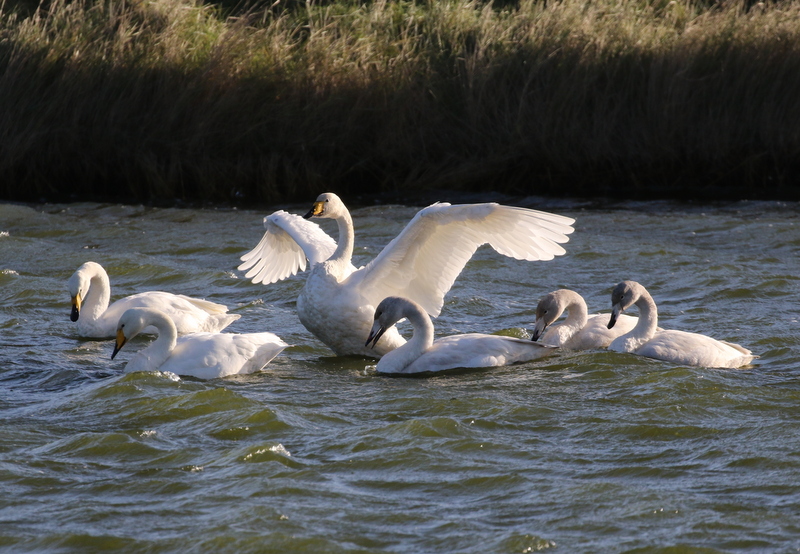 Whooper Swans – one of two families on the northern pit at Snettisham
Whooper Swans – one of two families on the northern pit at Snettisham
It was getting on for high tide already, but it was not a particularly big tide today which meant that the waders would not be pushed very high up the mud. Scanning from the seawall, we could see huge flocks of waders out over the mud, thousands of Knot and smaller numbers of Bar-tailed Godwits in particular. Closer to us, little groups of Dunlin were more spread out, feeding feverishly.
Many of the flocks were seeking whatever shelter from the wind they could find out on the exposed mud. We got a group of Knot in the scope which were crammed tight in a small depression. On the edge of the channel down in from of us, down at of the wind, was a little huddle of Dunlin, together with a Grey Plover and a Redshank, all trying to sleep.
We took shelter in Rotary Hide to scan the mud. Looking out to the edge of the Wash, we could see long lines of Gannets battling north. They had been blown into the Wash by the strong north wind and were now trying to work their way back out again along the eastern shore. A couple of juvenile Gannets tried flying in across the mud instead, flushing the flocks of Knot which were not sure exactly what was flying overhead.
 Gannet – trying to make its way back north, out of the Wash
Gannet – trying to make its way back north, out of the Wash
Over on the edge of the water we could see a couple of large flocks of sleeping Oystercatchers, looking like a black smear along the shore line in the distance. Three Sanderling were much closer, landing on the near edge of the channel and running along on the mud.
Looking out the other side of Rotary Hide, we found one of the two Black-necked Grebes which have been here for a few days now. It was hard viewing from here, as we were looking into the morning sun. The water was also very choppy. whipped up by the blustery wind. The Black-necked Grebe was diving continually, with a couple of Little Grebes too, a little further back.
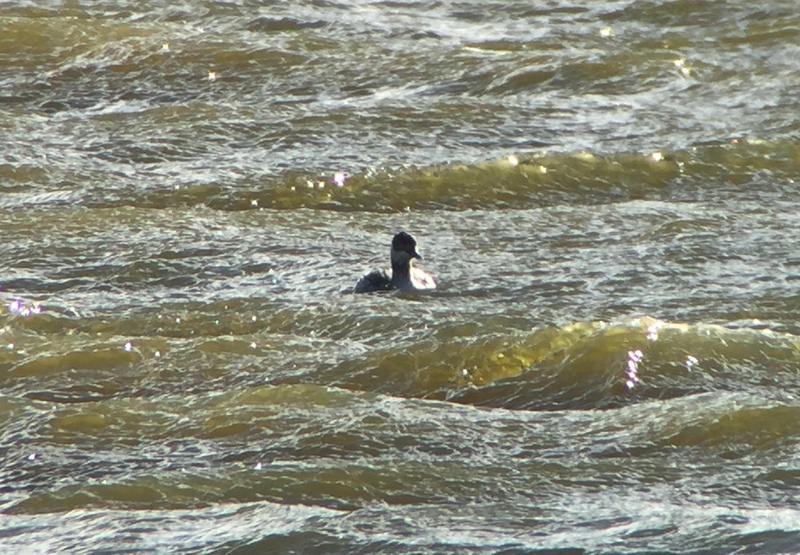 Black-necked Grebe – one of two on the southern pit again today
Black-necked Grebe – one of two on the southern pit again today
Braving the elements again, we walked further down along the seawall. A lone drake Pintail was on one of the small pools on the near edge of the mud as we passed so we stopped for a closer look at it. It was a smart drake, largely out of eclipse but still without its long pin-shaped tail.
 Pintail – on its own out on the mud on the edge of the Wash
Pintail – on its own out on the mud on the edge of the Wash
Round at Shore Hide we got ourselves out of the wind again. We had a better view across the pit from here, with the sun away to our right. Almost immediately we found the Scaup, bobbing about on the water in front of the hide. It was a 1st winter drake, just starting to get some grey feathers on its back and white on the rear flanks, and with a dirty white face.
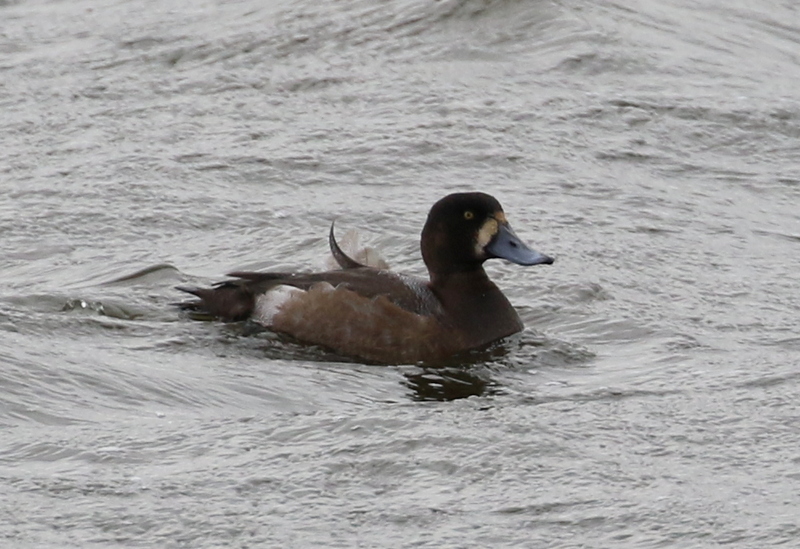 Scaup – the first winter drake on the pit
Scaup – the first winter drake on the pit
The second Black-necked Grebe was also diving continually, a little further out behind the Scaup. As were a smart pair of Goldeneye. At first, they were rather distant, down at the southern end of the pit, but after a while they reappeared over in front of the far bank, out from the hide. There was a nice selection of dabbling ducks too, mostly Wigeon in various stages of moult, plus a few Shoveler and a lone pair of Gadwall. We stopped to admire the drake Gadwall, a most under-appreciated bird!
There were comparatively few waders on the pits today. With the small tide, they were not going to be pushed off the Wash. However, there was a tight huddle of fifty or so Redshank on the edge of one of the islands. The vast majority of them were Common Redshank, but a closer look revealed a single Spotted Redshank in with them. They were all asleep at first, but still it was possible to pick the Spotted Redshank out at the back of the flock – it was a slightly paler shade of grey, more silvery-grey than the slaty coloured Common Redshanks, and through the scope we could see the much more marked white supercilium in front of the eye. Eventually something spooked them and they woke up, at which point it was possible to see the Spotted Redshank’s longer, needle fine bill.
It had been gloriously sunny for the most part at Snettisham, but as we drove back to the north coast we could see some rain clouds coming in off the sea and it started to rain as we turned the corner. We planned to spend the afternoon at Titchwell, but we made a quick detour down to Holme on the way there. There had been a large flock of Waxwings here for the last couple of days. As we drove down the reserve entrance track, we couldn’t see any, but on our way back with the windows open we heard them flying over and saw them land in the hedge behind us, down near Redwell Marsh.
A quick about turn and we managed to get good views of the Waxwings through the scope from the road, in the top of a hawthorn. We walked round and down the footpath to Redwell Marsh, hoping to get a little closer, but by the time we got there they had disappeared. As we made our way back to the road, we heard them calling and they flew over, 25-30 in total, and disappeared over in the direction of the village.
At least it had stopped raining, but it was still rather overcast while we were here. We did see a few other birds. There were lots of Blackbirds and a few Redwing in the hedges, and a couple of Fieldfares flew over as we walked along the road. A Kingfisher zipped over but disappeared down into the river channel out of view. With the Waxwings having disappeared, we didn’t hang around and moved quickly on to Titchwell. On the way there, we could see a huge flock of Fieldfare feeding in a winter wheat field by the main road, presumably recently arrived from the continent.
After lunch at Titchwell, we made our way out onto the reserve. It was very blustery out on the main path, but we stopped for a quick look over Thornham grazing marsh and the dried up pool. We found the Water Pipit which had been frequenting the puddles here recently, but it was right at the back and unfortunately disappeared into the vegetation before everyone could get onto it. A Marsh Harrier hung over the reedbed at the back.
Island Hide offered us some welcome shelter from the wind. The water level on the freshmarsh is going up fast now, as the warden tried to get the vegetation under control. Consequently, there are fewer waders on here at the moment. A single Ruff was picking around in the vegetation on the edge of the cut reeds beside the hide, and a few more Ruff were further out on the islands. While we were scanning, at least 30 more Ruff flew in, one of them with a noticeably very white head. Even in winter, they can be very variable, underlining why Ruff is probably the most often confused wader.
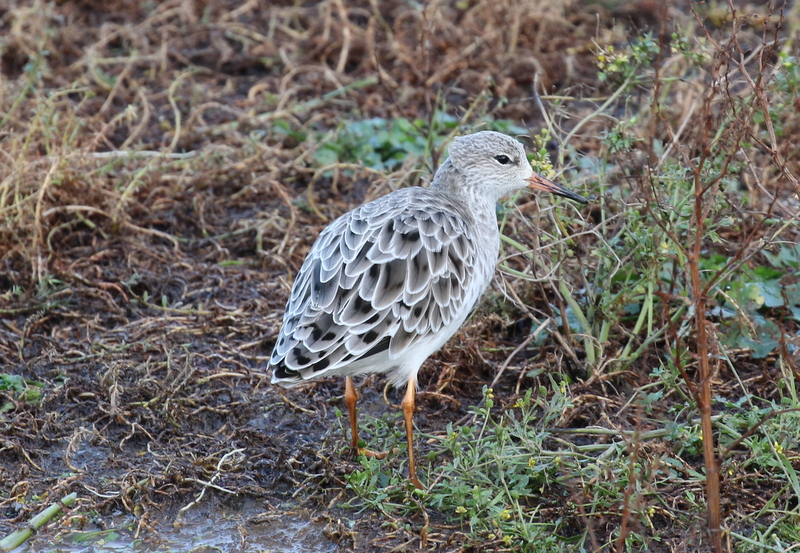 Ruff – in winter plumage, feeding in the vegetation close to Island Hide
Ruff – in winter plumage, feeding in the vegetation close to Island Hide
There were lots of ducks on the freshmarsh. Large numbers of Wigeon and Teal in particular, with some of the drakes looking increasingly smart as they have now mostly emerged from their duller eclipse plumage. In with them, were smaller numbers of Gadwall and Shoveler.
Good numbers of gulls were seeking shelter from the wind and loafing around on the water or on the islands. The Great Black-backed Gulls had probably sought refuge from the brunt of the wind out on the beach, where they would normally be. A single Yellow-legged Gull was asleep on one of the islands at first, but eventually woke up and showed us its bright yellow legs. It was also noticeably darker mantled than the nearby Herring Gulls.
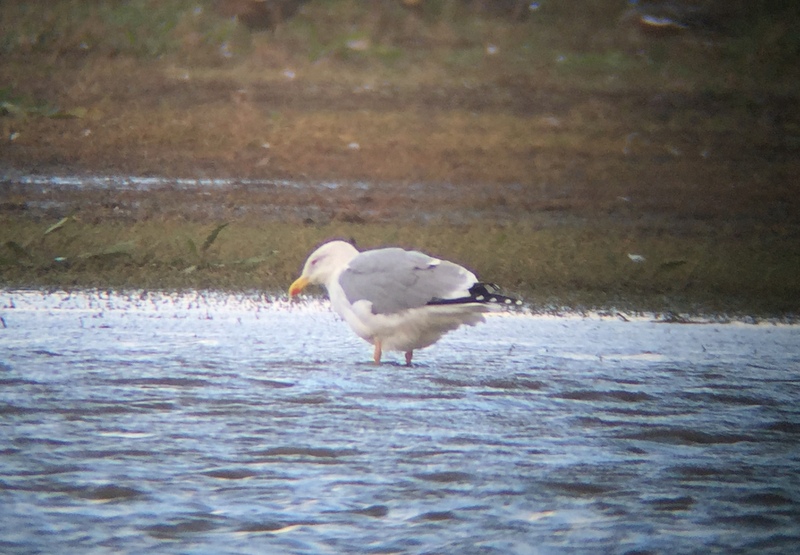 Yellow-legged Gull – one was amongst all the gulls on the freshmarsh today
Yellow-legged Gull – one was amongst all the gulls on the freshmarsh today
Round to Parrinder Hide and we called in on the north side first. A Curlew feeding in front of the hide was the highlight. Otherwise, there were several Redshank and a distant Grey Plover out on Volunteer Marsh. The islands of vegetation can sometimes conceal a lot of birds on here and down below us we could see a mob of Wigeon and Teal attacking the plants.
 Curlew – feeding in front of Parrinder Hide on the Volunteer Marsh
Curlew – feeding in front of Parrinder Hide on the Volunteer Marsh
On the other side of Parrinder Hide, overlooking the freshmarsh, there were two Common Snipe feeding just below the hide, although they quickly scurried away further along the bank. There are not so many places for them to hide here now, since the reeds on the bank have been cut down
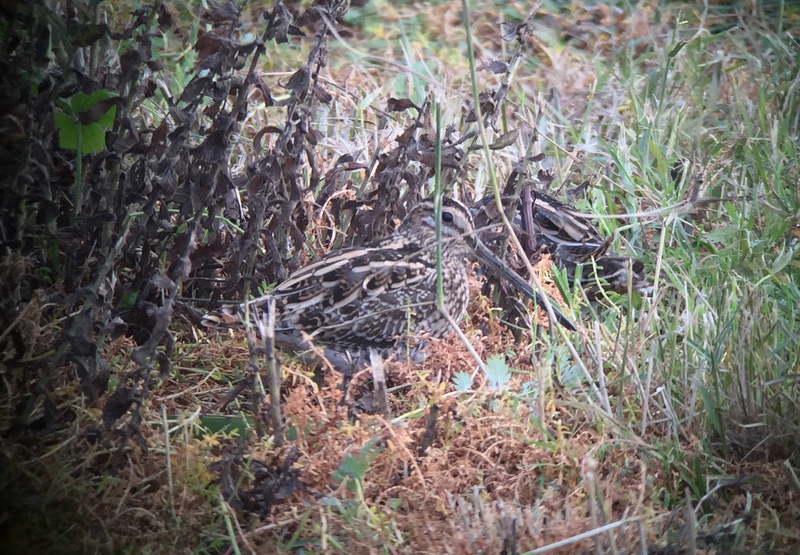 Common Snipe – feeding on the bank outside Parrinder Hide
Common Snipe – feeding on the bank outside Parrinder Hide
The piles of cut vegetation proved to be a perfect perch for a couple of Stonechat. They had been feeding from the fence around the island further over, dropping down from the posts to the ground. They gradually worked their way along, closer to us, and switched to using the mounds of cut reed as vantage points instead.
A smart drake Shoveler was feeding out on the water in front of the hide. When they are feeding, Shoveler swim around with their enormous bills under the water, stirring up food and then filtering it out with their bills. They can do this for long periods without lifting their heads out – making them very tricky to photograph!
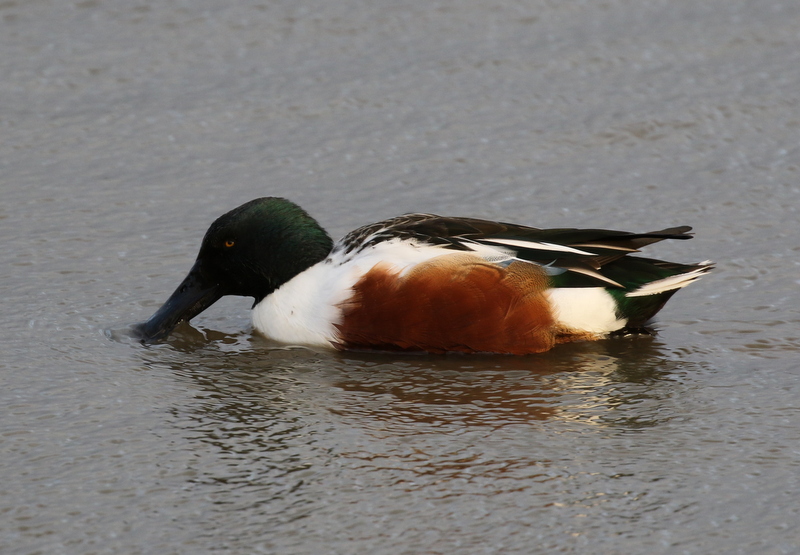 Shoveler – a smart drake feeding in front of Parrinder Hide
Shoveler – a smart drake feeding in front of Parrinder Hide
There have been some White-fronted Geese at Titchwell for a week or so now. They seem to move between the maize field along the entrance road and the freshmarsh. Today, they were feeding on the fenced off island with all the Greylags. It was hard to tell exactly how many there were. There was the usual family party, two adults and two juveniles, and at least one further adult today.
When the adult White-fronted Geese raised their heads, you could see the distinctive white band around the base of their bills. At one point, as they came out of the vegetation, you could also see the black bands on their bellies. The two juvenile White-fronted Geese lacked the white face and black belly bars, but were still smaller and darker than the Greylags, with a pink bill.
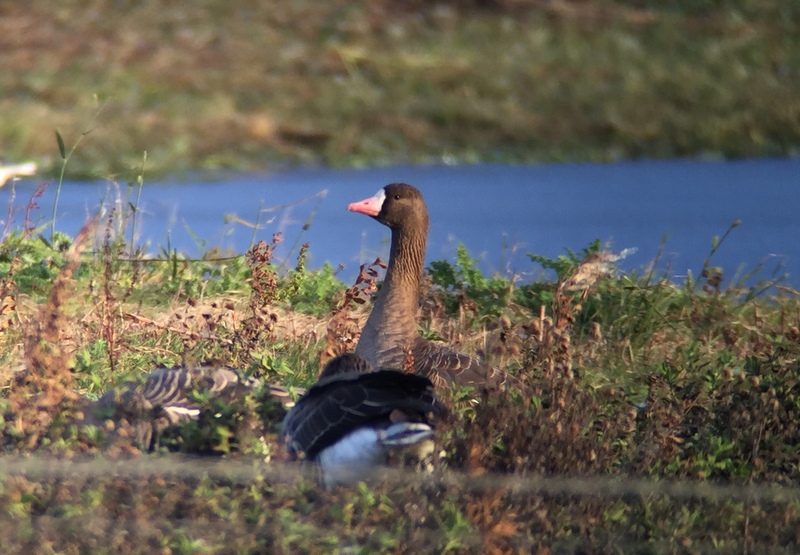 White-fronted Goose – one of the adults, raising its head
White-fronted Goose – one of the adults, raising its head
There didn’t seem to be any Avocets left here are first. Most of the birds which breed here or gather post-breeding, have long since left for warmer climes further south. Most years, a small number linger on through into the winter. Eventually we found them, six Avocets lurking right in the back corner of the freshmarsh.
It seems rude to visit Titchwell without at least seeing the sea. We did make a quick sortie out to the beach today, to finish the day. As we passed the Volunteer Marsh, a little group of Dunlin were feeding along the channel right by the main path. Out on the tidal pools, there were a couple of Black-tailed Godwit and a Grey Plover. However, we didn’t linger on the walk out today, given the wind, but headed straight on to the sea.
As we got to the beach, we could see a squally shower blowing in and the first spots of rain were blowing in to our faces. The sea was rough, which would make it tricky to see any birds out here anyway. Still, it is always amazing to see the fury of the sea on a stormy day. With the rain starting to come in, we beat a hasty retreat.
Walking back past the freshmarsh, there were lots of birds coming in to roost. Lines of Black-headed Gulls flew in from the fields and another flock of Ruff came in over the reedbed and grazing marshes. A Marsh Harrier drifted in from the Thornham direction and headed off over the reedbed. With the light fading, it was time for us to call it a day too. The weather hadn’t been anyway near as bad as forecast and we had still managed to see a great selection of birds, despite the windy conditions.
















